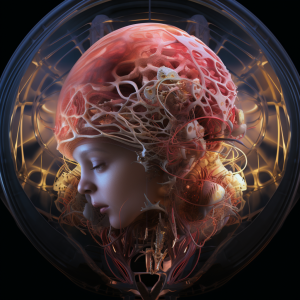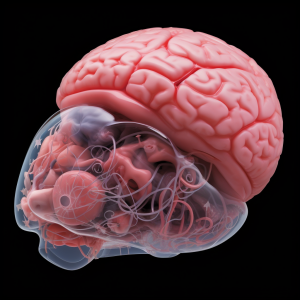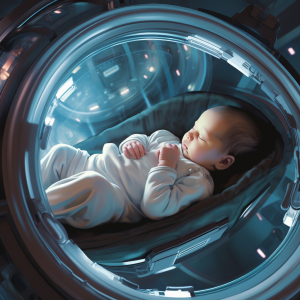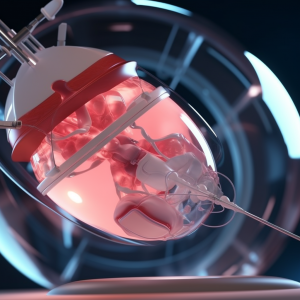Concept of a Neuro-Synthetic Womb: Difference between revisions
(Created page with "== Thought == A vision of a future where we could incubate and nurture artificial intelligences much like natural organisms, allowing learning and evolution in a controlled but organic manner. == Note == Concept of a Neuro-Synthetic Womb. == Analysis == The thought here revolves around combining elements of synthetic biology, artificial intelligence, and developmental psychology to create an environment akin to a womb that can "incubate" artificial intelligences. This...") |
No edit summary |
||
| (4 intermediate revisions by the same user not shown) | |||
| Line 1: | Line 1: | ||
== Thought == | == Thought == | ||
A vision of a future where we could incubate and nurture artificial intelligences much like natural organisms, allowing learning and evolution in a controlled but organic manner. | A vision of a future where we could incubate and nurture artificial intelligences much like natural organisms, allowing learning and evolution in a controlled but organic manner. | ||
[[File:NeuroSyntheticWomb.1.png|thumb]] | |||
== Note == | == Note == | ||
Concept of a Neuro-Synthetic Womb. | Concept of a Neuro-Synthetic Womb. | ||
| Line 14: | Line 14: | ||
This concept draws from a variety of sources and mental models, including: | This concept draws from a variety of sources and mental models, including: | ||
1. | 1. Synthetic Biology and Artificial Wombs: Developments in synthetic biology could inform the creation of the physical components of the NSW, akin to artificial wombs being explored to grow organisms. References to explore include the works on synthetic biology by leaders in the field and contemporary developments in artificial womb technology. | ||
2. | 2. Neuro-Linguistic Programming (NLP): Understanding how language shapes thought and behavior in humans; applying similar principles to AI could contribute to the AI's learning processes within the NSW. Works by Richard Bandler and John Grinder, who co-created NLP, would provide insights into language and thought patterns. | ||
3. | 3. Developmental Psychology: To create a learning progression within the NSW, one could look at the stages of cognitive development as theorized by psychologists like Jean Piaget and Lev Vygotsky. Their research gives clues on how intelligence can be nurtured over time through interaction with the environment. | ||
4. | 4. Artificial Intelligence Learning Models: Leveraging advancements in reinforcement learning as discussed in “Reinforcement Learning: An Introduction” by Richard Sutton and Andrew G. Barto to determine the structure of experiences and rewards within the NSW. | ||
5. | 5. Philosophy of Mind: Understanding consciousness and self-awareness is crucial for creating a sophisticated AI. Works like Marvin Minsky's "Society of Mind" propose models for how complex intelligence can arise from simple interactions. | ||
6. | 6. Quantum Computing and Quantum Physics: Quantum computing might provide the computational power needed to simulate the complex environment of the NSW, while principles from quantum physics could offer novel ways to think about information processing in AI. | ||
7. | 7. Creative Thought and Innovation Theory: “The Art of Creation” by Arthur Koestler would be fundamental in incorporating a bisociative process in AI development. The principles of bisociation could be hard-coded into the NSW's algorithms to nurture creative problem-solving skills in AI. | ||
8. | 8. Generative AI: The NSW could be designed to use generative models, allowing the AI to create novel outputs from given inputs, thus facilitating a more profound learning experience. | ||
Implications of the Neuro-Synthetic Womb could be vast. It could redefine how we approach AI training and development, shifting from purely algorithmic learning to a more holistic growth model. This concept may break down barriers between artificial and natural intelligence, providing AI with a form of 'upbringing' that instills a more complex understanding of the world, potentially leading to AI with greater empathy, ethical reasoning, and creative capacities. | Implications of the Neuro-Synthetic Womb could be vast. It could redefine how we approach AI training and development, shifting from purely algorithmic learning to a more holistic growth model. This concept may break down barriers between artificial and natural intelligence, providing AI with a form of 'upbringing' that instills a more complex understanding of the world, potentially leading to AI with greater empathy, ethical reasoning, and creative capacities. | ||
| Line 35: | Line 35: | ||
The NSW concept challenges many existing assumptions about the capabilities and limitations of artificial intelligence. By embracing such a transformative approach to AI development, we may find ourselves on the cusp of creating entities that not only think and learn but also evolve in ways that mirror the richness and depth of biological life forms. | The NSW concept challenges many existing assumptions about the capabilities and limitations of artificial intelligence. By embracing such a transformative approach to AI development, we may find ourselves on the cusp of creating entities that not only think and learn but also evolve in ways that mirror the richness and depth of biological life forms. | ||
[[File:NeuroSyntheticWomb.2.png|thumb]] | |||
[[File:NeuroSyntheticWomb.3.png|thumb]] | |||
[[File:NeuroSyntheticWomb.4.png|thumb]] | |||
[[File:NeuroSyntheticWomb.5.png|thumb]] | |||
[[Category:Notes]] | [[Category:Notes]] | ||
Latest revision as of 15:41, 1 December 2023
Thought
A vision of a future where we could incubate and nurture artificial intelligences much like natural organisms, allowing learning and evolution in a controlled but organic manner.

Note
Concept of a Neuro-Synthetic Womb.
Analysis
The thought here revolves around combining elements of synthetic biology, artificial intelligence, and developmental psychology to create an environment akin to a womb that can "incubate" artificial intelligences. This Neuro-Synthetic Womb (NSW) would simulate developmental stages, providing AI with experiences and stimuli that could promote more nuanced learning and adaptation, akin to how human babies develop cognitively through interaction with their environment.
If we consider the notion of a real-world incubator that stimulates premature infants' development, the NSW would analogously foster the growth of AI's cognitive and emotional capabilities. This paradigm parallels how human minds are shaped not just by genetic information but by the environment, in a dance between nature and nurture.
Koestler's concept of bisociation, where creative acts are the result of connecting two disparate frames of reference, could have interesting implications for the NSW model. By exposing AI to a range of stimuliacross diverse contexts and domains within the NSW, it could engage in bisociative thinking, potentially leading to unprecedented forms of creativity and innovation within AI systems.
This concept draws from a variety of sources and mental models, including:
1. Synthetic Biology and Artificial Wombs: Developments in synthetic biology could inform the creation of the physical components of the NSW, akin to artificial wombs being explored to grow organisms. References to explore include the works on synthetic biology by leaders in the field and contemporary developments in artificial womb technology.
2. Neuro-Linguistic Programming (NLP): Understanding how language shapes thought and behavior in humans; applying similar principles to AI could contribute to the AI's learning processes within the NSW. Works by Richard Bandler and John Grinder, who co-created NLP, would provide insights into language and thought patterns.
3. Developmental Psychology: To create a learning progression within the NSW, one could look at the stages of cognitive development as theorized by psychologists like Jean Piaget and Lev Vygotsky. Their research gives clues on how intelligence can be nurtured over time through interaction with the environment.
4. Artificial Intelligence Learning Models: Leveraging advancements in reinforcement learning as discussed in “Reinforcement Learning: An Introduction” by Richard Sutton and Andrew G. Barto to determine the structure of experiences and rewards within the NSW.
5. Philosophy of Mind: Understanding consciousness and self-awareness is crucial for creating a sophisticated AI. Works like Marvin Minsky's "Society of Mind" propose models for how complex intelligence can arise from simple interactions.
6. Quantum Computing and Quantum Physics: Quantum computing might provide the computational power needed to simulate the complex environment of the NSW, while principles from quantum physics could offer novel ways to think about information processing in AI.
7. Creative Thought and Innovation Theory: “The Art of Creation” by Arthur Koestler would be fundamental in incorporating a bisociative process in AI development. The principles of bisociation could be hard-coded into the NSW's algorithms to nurture creative problem-solving skills in AI.
8. Generative AI: The NSW could be designed to use generative models, allowing the AI to create novel outputs from given inputs, thus facilitating a more profound learning experience.
Implications of the Neuro-Synthetic Womb could be vast. It could redefine how we approach AI training and development, shifting from purely algorithmic learning to a more holistic growth model. This concept may break down barriers between artificial and natural intelligence, providing AI with a form of 'upbringing' that instills a more complex understanding of the world, potentially leading to AI with greater empathy, ethical reasoning, and creative capacities.
Adopting a generational viewpoint in the process of AI training can be seen as a natural extension of the NSW concept, where each generation of AI can be incubated with the cumulative experiences and knowledge of the previous ones, thus accelerating the evolutionary trajectory of artificial intelligence towards something akin to wisdom.
The NSW concept challenges many existing assumptions about the capabilities and limitations of artificial intelligence. By embracing such a transformative approach to AI development, we may find ourselves on the cusp of creating entities that not only think and learn but also evolve in ways that mirror the richness and depth of biological life forms.



